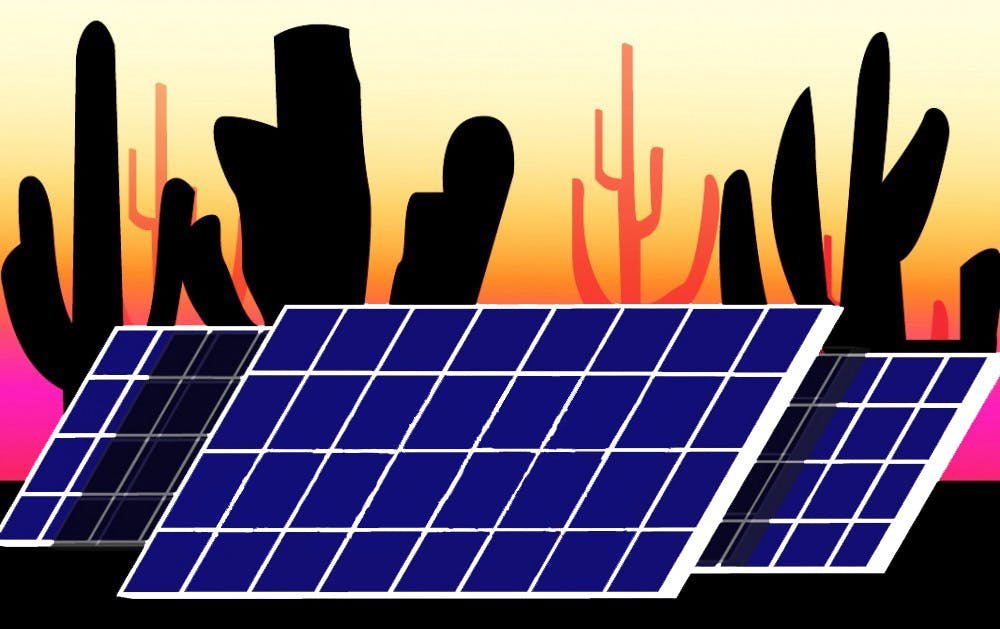Despite increased economic opportunities in the solar energy sector, policy-based social inequities still pose barriers to progress.
Martin Pasqualetti is a professor at the School of Geographical Sciences and Urban Planning and former co-director of the Energy Policy Information Council. According to him, solar power presents many unique advantages over other sources.
"(Solar power is) renewable, we don't have to pay for (the sun), it's always available ... and there's a great interest in it now because it's the lowest cost per megawatt basis," Pasqualetti said.
As a newer and more sophisticated technology, solar plants are more expensive than traditional energy plants to build, however, they avoid the costs associated with fuel.
Amanda Ormond is a professor of practice in the Julie Ann Wrigley Global Futures Laboratory and the co-founder and co-director of the Just Energy Transition Center.
"When you build a wind and solar plant, all the costs are upfront, and when the wind blows, you don't have any cost after that," Ormond said. "With a coal fire power plant, you build the plant, it's probably cheaper to build, but you'll be paying for coal for the whole operation."
This, as well as the lack of toxic pollutants that are common in traditional energy plants, further add to its appeal as an economic and environmental asset.
However, despite the economic and environmental improvements in the solar industry, social inequities are still a primary concern.
Hanna Breetz is an assistant professor at the School of Sustainability and a Senior Global Futures Scientist at the Julie Ann Wrigley Global Futures Laboratory.
"(During) a lot of the early decades of this, the big debates were about finding ways to improve renewable technologies, demonstrate that they work and bring down the cost," Breetz said. "But we are getting to a place where new challenges are emerging, and a lot of these challenges are on the social side of things."
Communities that are economically reliant on conventional energy plants such as natural gas and coal are at risk of being unintentionally harmed by the transition to renewable alternatives. Ormond, through her role at JET, explores the social disruptions associated with transitioning to solar.
"(JET) was actually started when we knew that coal plants were going to close, and coal plants are huge economic engines in their communities," Ormond said. "As these plants closed, we built the center to help communities think about what comes next."
For those employed by these plants, the skill set required to fill new roles in solar plants is often different from their current training, and in some cases, new solar plants may be far from their original workplace, causing additional disruption.
"When there was a lot of concern about the job losses, there was this discourse about, well, we can just replace (them) with green jobs," Breetz said. "I would say now there is more of an awareness of the fact that that's not really a one-to-one trade."
Consumer solar panels present their own set of issues. Despite increased rates of adoption of distributive solar energy, which refers to localized solar panel units, the cost of electricity of conventional energy sources has not decreased.
Danae Hernandez-Cortes is an assistant professor at the School for the Future of Innovation in Society and has explored the consequences of renewable environmental policy throughout her work.
"One thing that makes it really hard is that, often, utilities price their electricity based on the number of users they have," Hernandez-Cortez said. "So if they have users that are using rooftop solar and are self-sufficient, then their energy costs are passed onto all the other users who don't have solar."
Today, solar energy, along with other renewables, is on track to play a bigger part in the energy equation. However, change is and will be slow.
"Utilities, their primary job is reliability," Ormond said. "To make sure the lights never go off. So as a culture, they're very risk-averse. They don't experiment well. They don't like taking chances and so any change around solar happens way slower."
Technologically, solar energy is capable of making improvements to the environmental impact of energy production. Because of this, policymakers could be responsible for the next step in solar energy innovation.
Edited by River Graziano, Abigail Beck and Madeline Schmitke.
Reach the reporter at nalbishr@asu.edu.
Like The State Press on Facebook and follow @statepress on X.




